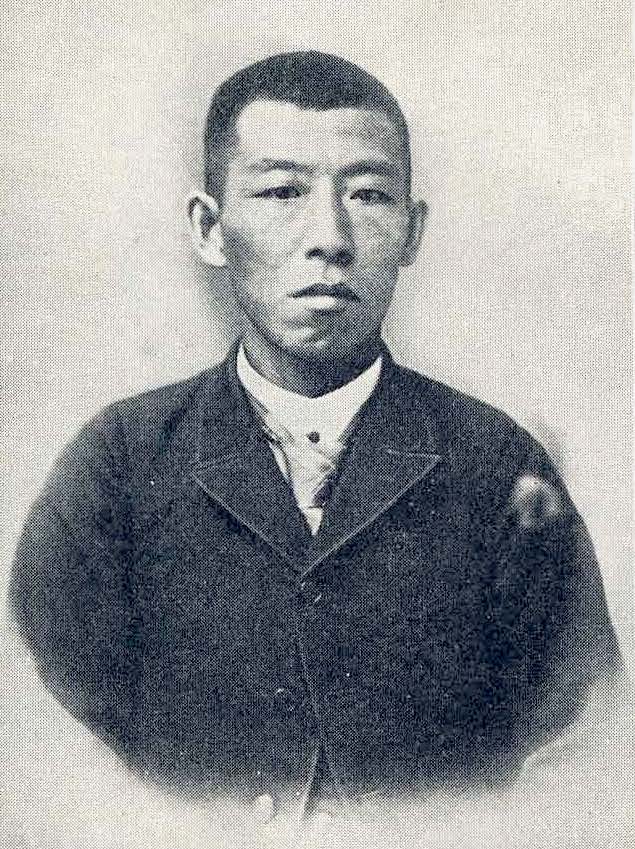
伊能 嘉矩
Inō Kanori, 1867-1925

☆ 伊能嘉矩(いのう かのり、1867年6月11日 - 1925年9月30日)は、台湾の先住民研究で知られる日本の人類学者、民俗学者である。伊能は、それまでの「熟蕃(じゅくばん)」(平定された・飼い慣 らされた蕃族)または「生蕃(せいばん)」(野生の蕃族)という曖昧な認識に代わる、原住民族をいくつかのグループに分類した最初の人物である。
| Inō Kanori
(伊能 嘉矩, 11 June 1867 – 30 September 1925) was a Japanese anthropologist
and folklorist known for his studies in Taiwanese indigenous peoples.
Ino was the first person who classified the aboriginal tribes into
several groups, instead of the traditional classification which
imprecisely recognized these aborigines only as "cooked/domesticated"
(熟蕃, jukuban) or "raw/wild" (生蕃, seiban). |
伊
能嘉矩(いのう かのり、1867年6月11日 -
1925年9月30日)は、台湾の先住民研究で知られる日本の人類学者、民俗学者である。伊能は、それまでの「熟蕃(じゅくばん)」(平定された・飼い慣
らされた蕃族)または「生蕃(せいばん)」(野生の蕃族)という曖昧な認識に代わる、原住民族をいくつかのグループに分類した最初の人物である。 |
| Biography Inō was born in Shinyashiki (新屋敷), Yokota Village (橫田村), Tono City (遠野市), what is now part of the city of Tōno, Iwate, Japan. He moved to Tokyo in 1885 and was active in the Freedom and People's Rights Movement. He later worked as a journalist and for a printing company before becoming a pupil of the noted professor of biological anthropology, Tsuboi Shogoro at Tokyo Imperial University in 1893, along with Torii Ryūzō. Following the acquisition of Taiwan by the Empire of Japan following the First Sino-Japanese War in 1895, he received permission from the Governor-General of Taiwan to conduct research there. He remained in Taiwan to 1906, publishing several works on the culture of the Taiwanese aborigines. In The Island of Formosa (1903), former US Consul to Formosa James W. Davidson presented the first English-language account of the aborigines of the whole island, which was almost entirely based on the comprehensive work collected over several years of study by Ino, the foremost authority on the topic at the time.[1] In his book, Davidson presented Ino's formalization of eight tribes of Taiwanese aborigines: Atayal, Vonum, Tsou, Tsalisen, Paiwan, Puyuma, Ami and Pepo. Inō returned to his native Tōno in 1905 and pursued cultural and folklore studies there, together with Kizen Sasaki. He became acquainted with Kunio Yanagita, who was also collecting the oral traditions and tales in preparation of his Tōno Monogatari. He died in 1925, due to complication from malaria contracted while he was living in Taiwan. |
経歴 伊能は、現在の岩手県遠野市遠野町新屋敷(橫田村新屋敷)で生まれた。1885年に東京に移り、自由民権運動に積極的に参加した。その後、ジャーナリスト や印刷会社勤務を経て、1893年に鳥居龍蔵とともに東京帝国大学で著名な自然人類学教授、坪井正五郎の弟子となった。1895年の日清戦争後、日本が台 湾を獲得すると、台湾総督府から台湾での調査を許可された。1906年まで台湾に滞在し、台湾原住民の文化に関する複数の著作を出版した。 『台湾島』(1903年)では、元在台米国領事のジェームズ・W・デビッドソンが、当時この分野における第一人者であった伊能の数年にわたる研究の集大成 をほぼ全面的に引用し、台湾全土の先住民に関する最初の英語による記述を提示した。[1] デビッドソンは著書の中で、伊能が体系化した台湾先住民の8つの部族を紹介している。タイヤル族、ボンム族、ツオウ族、ツァリセン族、パイワン族、プユマ 族、アミ族、ペポ族である。 1905年に猪野は故郷の遠野に戻り、佐々木喜善とともに文化・民俗学の研究を続けた。柳田国男とも知り合い、柳田もまた『遠野物語』の準備として口承の伝統や物語を収集していた。猪野は1925年に台湾でマラリアに感染し、その合併症により亡くなった。 |
| Contributions to Taiwan’s historiography Since Inō Kanori conducted the "survey on the preparation of educational facilities for aborigines," he had published several important and general articles on knowledge of Taiwan’s aborigines. In 1900, when Taiwan Customs Study Group (臺灣慣習研究會) was founded, Inō Kanori often published articles relating to old customs and folklore of Han Chinese in Taiwan on Articles on Taiwan Customs (《臺灣慣習記事》), marking his entrance into the realm of history from anthropology. In 1902, he published his first major work since he arrived in Taiwan: Chronicles of Taiwan (《臺灣志》). In 1908, he participated in the editorial work of Preface to the Greater Japan Dictionary of Geographical Names-Chapter of Taiwan. In 1922, when the Government-General established the Government-General of Taiwan Historical Materials Editorial Committee, Inō Kanori was hired as a committee member and compiled articles. When he passed away in 1925, he left a posthumous manuscript of The Complete History of Taiwan (《臺灣全史》) with as many as 54 volumes, which was published as Chronicles of Taiwan Culture (《臺灣文化志》) in 1928, and the renowned Japanese intellectual Ozaki Hotsuma who was in Taiwan praised Inō as "the authority of Taiwan’s historiography.” In the same year, most of Inō Kanori’s Taiwanese ethological specimens became part of Taihoku Imperial University's (臺北帝國大學, nowadays National Taiwan University) collection in the specimen room, while his books and manuscripts entered the university library, and was collectively named Inō Bunko (伊能文庫, “Ino’s book collection”). In 1941, famous Taiwanese scholar Yang Yunping (楊雲萍), who dedicated herself to the study of Taiwan’s history, appraised Inō as “the master of Taiwan studies” and “the immortal pyramid in the history of Taiwan studies.” In 1997, sorting of the Inō Bunko, which had stayed in National Taiwan University’s library for a long time, was finally complete, bringing Inō's achievements in Taiwan’s historiography to an even higher peak. His works were considered important references of Taiwan studies, and among the cultural and historical knowledge they offered, the Pepo survey record Chronicles of Politics of Taiwan Aborigines and Chronicles of Taiwan Culture were considered the most important. |
台湾史学への貢献 伊能嘉矩は「原住民教育施設準備調査」を実施して以来、台湾原住民の知識に関する重要かつ一般的な論文をいくつか発表している。1900年に台湾風俗研究 会(臺灣慣習研究會)が設立されると、伊能嘉矩はしばしば台湾風俗記事(《臺灣慣習記事》)に台湾の漢民族の古い風俗や民俗に関する記事を掲載し、人類学 から歴史学の領域に足を踏み入れた。1902年、彼は台湾に来てから最初の大著を出版した: 1902年、台湾に来てから最初の大著『台湾記』(《臺灣志》)を出版した。1908年、『大日本地名辞書』台湾編の序文の編集に携わる。1922年、台 湾総督府が台湾総督府歴史資料編集委員会を設置すると、伊能嘉矩は委員として採用され、記事をまとめた。1925年に逝去した際には、54巻にも及ぶ『台 湾全史』(《臺灣全史》)の遺稿を残している、 台湾に滞在していた日本の著名な知識人、尾崎冬馬は伊能を「台湾史学の権威」と称賛した。 」 同年、伊能嘉矩の台湾民族学標本の大半は台北帝国大学(臺北帝國大學、現在の国民大学)の標本室に収蔵され、伊能嘉矩の著書や原稿は大学図書館に収蔵さ れ、伊能文庫と総称された。1941年、台湾史研究に尽力した著名な台湾学者、楊雲平(楊萍)は、伊能を「台湾学の巨匠」「台湾学史上の不滅のピラミッ ド」と評した。1997年、長らく国民大学図書館に保管されていた伊能文庫の整理がようやく完了し、伊能忠敬の台湾史学における功績はさらなる高みに達し た。伊能の著作は台湾学の重要な参考文献とされ、その文化的・歴史的知識の中でも、『台湾原住民政治記』『台湾文化記』のペポ調査記録は最も重要なものと された。 |
| Bibliography Kanori Ino (2012). 平埔族調查旅行: 伊能嘉矩<台灣通信>選集 [Research trips among the Plains Aborigines: Selections from Inō Kanori's Taiwan diaries] (in Chinese). Translated by Yang Nanjun [in Chinese]. Taipei: Yuan-Liou. ISBN 9789573268932. |
書誌情報 伊能嘉矩 (2012). 平埔族調查旅行:伊能嘉矩<台灣通信>選集 [平原原住民の調査旅行: 伊能嘉矩の台湾日記からの抜粋](中国語)。楊南軍訳[中国語]. 台北:元立. ISBN 9789573268932. |
| https://en.wikipedia.org/wiki/In%C5%8D_Kanori |
|
| 伊能 嘉矩(い
のう かのり、慶応3年5月9日(1867年6月11日)[1] -
大正14年(1925年)9月30日[1])は、日本の人類学者・民俗学者。明治時代においていち早く人類学を学び、特に台湾原住民の研究では膨大な成果
を残した。郷里岩手県遠野地方の歴史・民俗・方言の研究にも取り組み、遠野民俗学の先駆者と言われた。梅陰[2]という筆名での著作も多数ある。 |
|
| 来歴 慶応3年(1867年)、横田村(現在の岩手県遠野市東舘町)に生まれる[1]。父母を早くに亡くしたが、両祖父から漢学・国学・国史などを学び、若くし て学才を発揮する。明治18年(1885年)、上京して斯文黌に学ぶ。自由民権運動にも参加し、岩手県に戻り入学した岩手師範学校では寄宿舎騒動の首謀者 とみなされ放校処分を受ける。1889年3月、再び上京[1]。成達書院で漢学と歴史を学びながら[1]、東京毎日新聞社に入社[1]。その後、東京毎日 新聞、教育評論、教育報知、大日本教育新聞の記者を務めた[1]。明治26年(1893年)東京帝国大学で坪井正五郎から人類学を学び[1]、鳥居龍蔵と 出会った。明治27年(1893年)12月、鳥居と週一回行う人類学講習会を催した[1]。 明治28年(1895年)、日清戦争の結果、日本に割譲された台湾に目を付け、台湾総督府雇員となり[1][3]明治29年(1896年)8月多田綱輔 (中国語版)、宮村栄一と共に台湾に渡り、台湾全土にわたる人類学調査に取り掛かった。その調査結果は、『台湾蕃人事情』として台湾総督府民政部文書課か ら刊行された(粟野伝之丞との共著)。 1898年に一時帰国[1]。1899年12月(明治32年)台湾民政局殖産局の所属として台湾に戻るが[1]、1906年(明治39年)1月、祖父の面 倒を見るために再び帰国[1]。帰国後は、郷里遠野を中心とした調査・研究を行うようになる。この間の著作に『上閉伊郡志』『岩手県史』『遠野夜話』など がある。研究を通じて柳田國男と交流を持つようになった。郷里の後輩である佐々木喜善とともに柳田の『遠野物語』成立に影響を与えた。 大正14年(1925年)、台湾滞在中に感染したマラリアが再発するという思いがけない死を迎えた。59歳であった。死後、柳田は伊能の残した台湾研究の遺稿の出版に力を注ぎ、それは昭和3年(1928年)『台湾文化志(中国語版)』として刊行された。 |
|
| 荻野馨 編『伊能嘉矩 年譜 資料 書誌』遠野物語研究所、1998年。 NCID BA40645399。 遠野市立博物館 編『伊能嘉矩と台湾研究』遠野市立博物館、2017年。 |
|
| 山田仁史 「伊能嘉矩 - 『遠野物語』の先駆者」『東北人の自画像』 三浦秀一編、東北大学出版会、2008年、87-128頁。 |
|
| 柳田國男 鳥居龍蔵 佐々木喜善 ニコライ・ネフスキー 金田一京助 後藤新平 |
|
| https://x.gd/RR2rN |
リ ンク
文 献
そ の他の情報
CC
Copyleft, CC, Mitzub'ixi Quq Chi'j, 1996-2099
☆
 ☆
☆